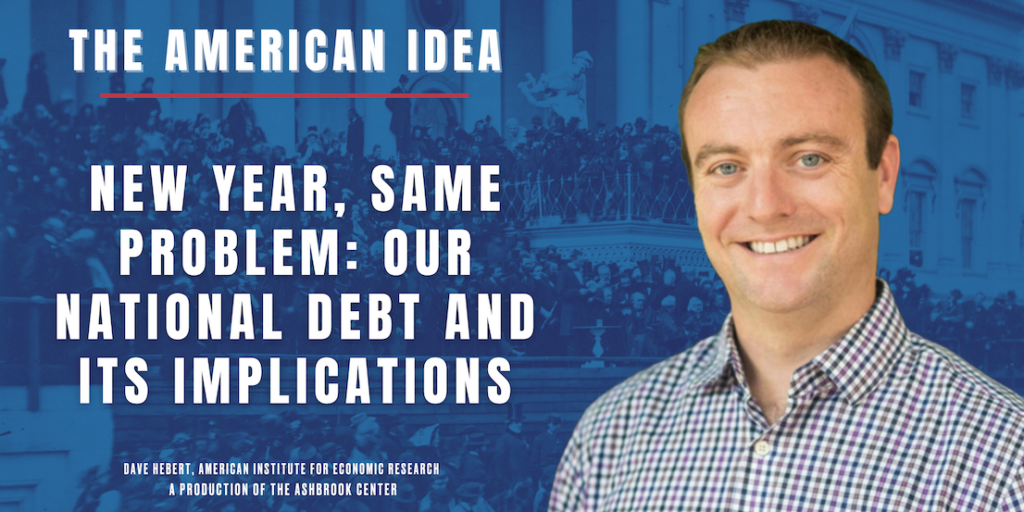New Year, Same Problem: Our National Debt and Its Implications
January 15, 2025

Listen and subscribe to the podcast
Join The American Idea’s Listener Email list – get news about upcoming episodes and a chance to offer questions for them, too!
America’s National Debt: A Crisis in the Making
The United States stands at a crossroads, burdened by a national debt that has ballooned to $36.3 trillion. This figure is staggering—over $100,000 for every person in the country—and its implications are profound. Far from being a mere abstraction on a balance sheet, the national debt represents a looming challenge that touches every aspect of American economic life. Understanding how the debt reached this point, the consequences of its continued growth, and the difficult choices required to address it is essential for all citizens.
A Century of Debt Accumulation
The roots of America’s debt problem stretch back over a century, but its recent growth is unprecedented. In just four months, $1.3 trillion was added to the total, an increase that highlights the severity of the imbalance between spending and revenue. While some argue that this is primarily a revenue problem, evidence points to unsustainable levels of government expenditure as the primary driver. At $36.3 trillion, the debt now exceeds the nation’s entire annual GDP of $30 trillion, meaning the country owes more than it produces in a year. Even if all federal revenues were allocated solely to repaying the debt, without accounting for interest, it would be impossible to erase the deficit within a year.
This imbalance stems in part from systemic reliance on deficit spending. For decades, the federal government has issued bonds to finance spending that exceeds its income. These bonds are purchased predominantly by American investors, whose continued confidence is essential to the system’s stability. Yet, this very mechanism—meant to fund growth and stability—has now become a source of vulnerability. A loss of confidence in the government’s ability to manage its finances could lead to rising interest rates and a debt spiral, further burdening an already strained system.
The Economic Toll of Excessive Debt
The effects of a growing national debt are not confined to abstract calculations; they have real consequences for individuals and the broader economy. One of the most immediate impacts is the reduction in available funds for private borrowing. As the government absorbs a significant share of loanable funds, interest rates rise, making it more expensive for businesses and individuals to access credit. This dynamic stifles innovation and growth, particularly for small businesses that rely on affordable loans to expand operations.
Furthermore, servicing the national debt has become the second-largest federal expenditure, diverting resources from critical public programs. The consequences of this shift will be most acutely felt by low-income Americans who depend on these services. Programs like Social Security, Medicare, and Medicaid are already under strain. Without reform, these entitlement programs could face insolvency, leaving millions of Americans vulnerable.
Structural Reforms and Economic Realities
Efforts to address the national debt must begin with systemic changes. The debt ceiling, originally introduced to streamline wartime budgeting, has become a contentious political tool rather than an effective safeguard. Many economists argue for its elimination in favor of a more practical system that requires Congressional approval for specific expenditures. Such a change would foster accountability and reduce the political brinkmanship that has often delayed meaningful fiscal reform.
Entitlement reform is another essential, albeit controversial, component of debt reduction. Current programs are unsustainable in their present form, and incremental changes will not suffice. Proposals to transition to cash payments or shift responsibilities back to private charities are among the ideas gaining traction. While politically sensitive, these measures could help contain costs while maintaining essential safety nets for the most vulnerable populations.
The notion that economic growth alone can resolve the debt crisis is a comforting but flawed illusion. Historically, the U.S. has relied on periods of rapid economic expansion to mitigate rising debt. However, today’s economic environment presents unique challenges. The globalized economy has made growth more reliant on imports, exacerbating trade deficits and limiting the potential for domestic revenue increases. Moreover, structural shifts in the workforce, such as the decline in manufacturing jobs and resistance to technological advances in key industries, have further constrained growth.
The Path Forward
The severity of the national debt crisis demands immediate and sustained action. The incoming Trump administration must confront the issue head-on, prioritizing fiscal discipline over short-term political gains. Restoring investor confidence in the government’s fiscal responsibility is critical. Without it, the U.S. risks undermining its standing as the issuer of the world’s reserve currency, a position that has long afforded it unparalleled economic advantages.
While a complete resolution of the debt crisis may be unrealistic in the near term, incremental progress is both possible and necessary. Reducing discretionary spending, reforming entitlement programs, and fostering a more innovative and competitive economy are all steps in the right direction. However, these measures require political will and public support, two resources often in short supply.
A Moment of Reckoning
America’s national debt is more than a financial problem; it is a test of the country’s ability to govern itself effectively. The debt’s sheer magnitude underscores the urgency of decisive action. As the nation grapples with this challenge, it must balance the need for economic stability with the imperative to invest in its future. Failure to do so risks not only financial turmoil but also the erosion of the trust and confidence that underpin the American economy.
This moment calls for bold leadership and a renewed commitment to fiscal responsibility. The path ahead will not be easy, but it is one that must be taken to secure a stable and prosperous future for generations to come.

